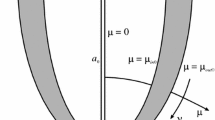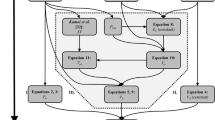Abstract
A mathematical model of left ventricular (LV) function in the dog has been developed. Based on a time-varying systolic elastance, the fitting procedure combined a local search according to a second-order method with a global heuristic search and provided beat-to-beat uncertainty intervals for each of the model parameters. Experiments were performed on anesthetized open-chest dogs in which the LV pressure and aortic flow were measured. The model formulated for the LV elastance appeared to be satisfactory for different contracting conditions including isovolumic or auxobaric beats. The study was focused on the maximal isovolumic elastance which, unlike the end-systolic elastance, has been found to be independent of both the preload and afterload and closely dependent on the contractile state of the LV.
Similar content being viewed by others
References
Beneken, J.E.W. Investigation on the regulatory system of the blood circulation. In:Circulatory Analog Computers, edited by A. Noordergraafet al. Amsterdam: North-Holland Pub. Cy., 1963, pp. 16–27.
Bonnemay, A. Un algorithme rapide de minimalisation statique. Comparaison avec d'autres algorithmes.C.R. Acad. Sci. Paris 272:1514–1517, 1972.
Clark, J.W., R.C. Pruett, D.L. Baldridge, R. Srinivasan, H.M. Bourland, J.S. Cole, and R.W. Brower. Functional model for the characterisation of the ventricular mechanics of the human subject.Med. Biol. Eng. Comput. 15:335–348, 1977.
Defares, J.G., H.H. Hara, J.J. Osborn, and J. McLeod. Theoretical analysis and computer simulation of the circulation with special reference to Starling properties of the ventricles. In:Circulatory Analog Computers, edited by A. Noordergraafet al. Amsterdam: North-Holland Pub. Cy., 1963, pp. 91–121.
Demoment, G. Application de la méthode du modèle à l'étude d'un système biologique complexe: Le ventricule gauche.Automatisme. 19:591–600, 1974.
Demoment, G. Validation d'un modèle du ventricule gauche par méthodes globales.Automatisme. 22:273–283, 1977.
Deswysen, B.A. Parameter estimation of a simple model of the left ventricle and of the systemic vascular bed, with particular attention to the physical meaning of the left ventricular parameters.IEEE Trans. Biomed. Eng. BME-24:29–38, 1977.
Deswysen, B.A. Identification d'un modèle simple du système cardiovasculaire: Évaluation des changements de charge et de contractilité. Thèse de doctorat en sciences appliquées. Université Catholique de Louvain, Belgium, 1977.
Donders, J.J.H., J.C. Zuidervaart, J.P. Rogijn, and J.E.W. Beneken. Estimation of heart function parameters by hybrid optimization techniques. In:Identification and System Parameter Estimation, Proceedings of the 3rd IFAC Symposium, edited by P. Eykhoff. Amsterdam: North-Holland/American Elsevier, 1973, pp. 221–230.
Hunter, W.C., J.S. Janicki, K.T. Weber, and A. Noordergraaf. Flow pulse response: A new method for the characterization of ventricular mechanics.Am. J. Physiol. 237:H282-H292, 1979.
Mereau, P., and G. Prevost. Calculation of uncertainty intervals in nonlinear estimation. In:Identification and System Parameter Estimation, edited by R. Isermann, 5th IFAC Symposium, 1979, pp. 365–372.
Richalet, J., A. Rault, and R. Pouliquen.Identification des Processus par la Méthode du Modèle. Paris: Gordon et Breach, 1971.
Sagawa, K. The ventricular pressure-volume diagram revisited.Circ. Res. 43:677–687, 1978.
Suga, H. Time-course of left ventricular pressure-volume relationship under various end-diastolic volume.Jpn. Heart. J. 10:509–515, 1969.
Suga, H. Time-course of left ventricular pressure-volume relationship under various extents of aortic occlusion.Jpn. Heart J. 11:373–378, 1970.
Suga, H., A. Kitabatake, and K. Sagawa. End-systolic pressure determines stroke volume from fixed end-diastolic volume in the isolated canine left ventricle under a constant contractile state.Circ. Res. 44:238–249, 1979.
Suga, H. and K. Sagawa. Instantaneous pressure-volume relationships and their ratio in the excised, supported canine left ventricle.Circ. Res. 35:117–126, 1974.
Suga, H., K. Sagawa, and A.A. Shoukas. Load independence of the instantaneous pressure-volume ratio of the canine left ventricle and effects of epinephrine and heart rate on the ratio.Circ. Res. 32:314–322, 1973.
Suga, H., K. Sagawa, and D.P. Kostiuk. Controls of ventricular contractility assessed by pressure-volume ratio,E max.Cardiovasc. Res. 10:582–592, 1976.
Suga, H., K. Sagawa, and L. Demer. Determinants of instantaneous pressure in canine left ventricle.Circ. Res. 46:256–263, 1980.
Author information
Authors and Affiliations
Rights and permissions
About this article
Cite this article
Demoment, G., Hinglais, J. Global parametric search and left ventricular identification. Ann Biomed Eng 9, 59–74 (1981). https://doi.org/10.1007/BF02584558
Issue Date:
DOI: https://doi.org/10.1007/BF02584558




